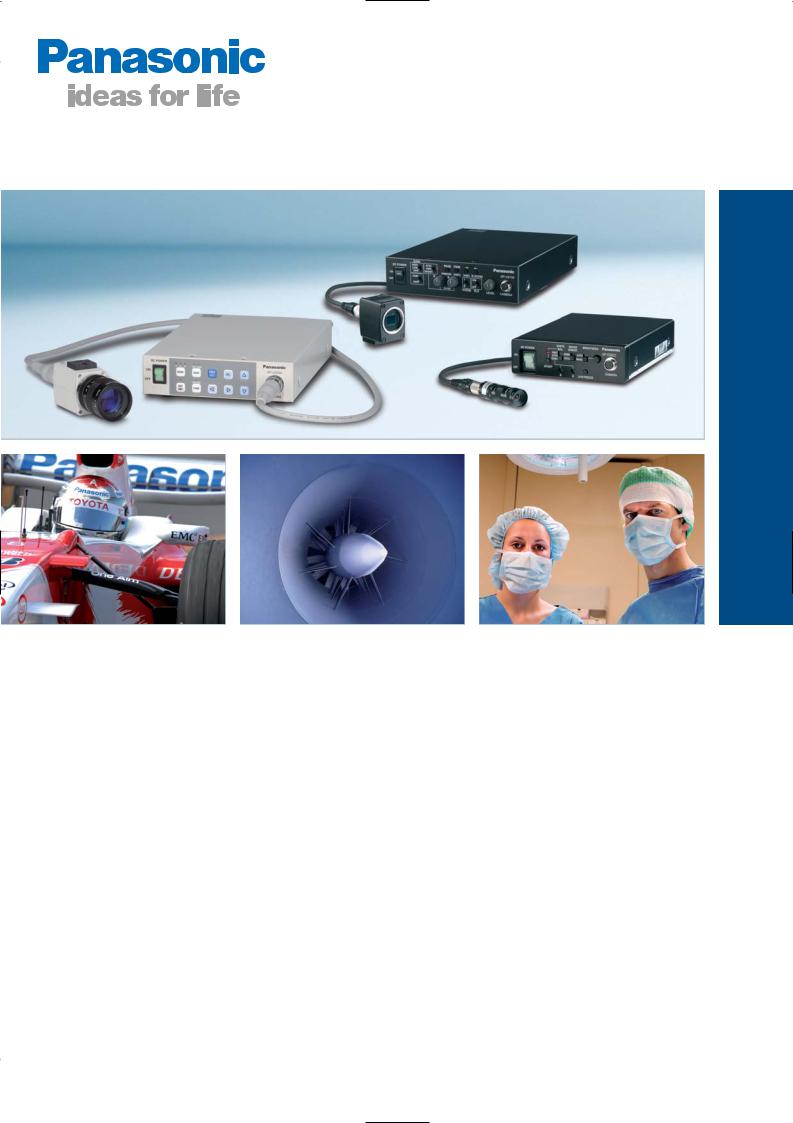Panasonic GP-US742, GP-KS842, GP-US532, GP-KS822, GP-US932 User Manual

CCD Micro Cameras
GP-US932 | GP-US742 | GP-KS822
Unparalleled flexibility – Quality wherever it counts
True HD
Progressive Scan
Brilliant Colour Reproduction
Compact Design
Digital Signal Processing

Panasonic Micro Cameras: More than just a point of view
Micro cameras are now capable of achieving what only complex specialised solutions hitherto could do: extremely high resolution, the purest colour reproduction and impressive accuracy. Panasonic's micro cameras guarantee maximum performance for the most diverse applications - and are also available as OEM components.
Dynamically digital
Panasonic’s micro cameras feature broadband and low-noise signal processing. The latest generation digital signal processors allow for flexible signal processing, for example, the brightness can be adjusted quickly and uniformly even in rapidly changing light conditions.
Our micro cameras boast a number of other practical, specialist functions:
•Freeze-frame
•2.5x continuous electronic zoom
•Frequency-independent 2D edge enhancement
•2D low-pass filter to control disruptive moiré effects
•Parallel definition of two or more user settings
•5 digital special filters, e.g. for red enhancement
Small in size – big on performance
To make our camera systems as small and compact as possible, we have separated the camera head from the
processing unit. Which means that the camera can even when space is at a premium. And despite scale, the control unit is as powerful as ever.
Progressive Scan:
Giving quality a boost
Conventional, linear image scanning (interlace) is suitable for capturing static images or for shots with increased light sensitivity. By contrast, progressive scanning used in Panasonic’s micro cameras captures the entire image, which is ideal for capturing moving objects. And the pictures are much sharper compared to those captured by interlace scanning.
Image captured with progressive scan
Image captured without progressive scan (interlace)
2

Compact solutions with built-in versatility
1CCD and 3CCD camera systems
A CCD component converts light signals into electric signals. With the 1CCD camera system, a colour filter separates the light into complementary colours which are all captured by just one CCD. In cameras that use the 3CCD approach, a prism splits the light into the three primary colours, namely red, green and blue. The individual colour information is sent to separate CCDs. Consequently, the brilliance of the colours, accuracy of detail and depth of focus are increased.
Heat-resistant components
In medical applications or specialist industrial solutions, micro cameras need to be extremely heat-resistant. Which is why selected components in our micro cameras can withstand temperatures of up to 125° C and can be integrated into autoclavable camera systems.
Well connected
Depending on the model, the control units on the Panasonic micro cameras are equipped with SDI, analogue RGB/component, S-Video and FBAS video outputs for flexible connectivity.
A powerful individual unit or a perfect integrated solution
The camera system components are designed to work in perfect harmony, and yet can also be combined with other products.
•Lenses: Panasonic special lenses or high-grade TV lenses from third-party manufacturers
•Heads: available in 1CCD and 3CCD versions and different sizes
•Cable: available in different lengths
•Control unit: varying functional range for 1CCD or 3CCD versions, with casing or circuit board
Easy to operate
We have developed a system of user-friendly on-screen menus to ensure easy and effective use of our micro cameras. This means you can change parameters quickly and clearly during operation. It is also extremely easy to save individual settings as presets for different users. The on-screen menu of OEM components can be adapted to customer requirements.
Colours
The Panasonic micro cameras' 6 or 12-axis colour matrix allows individual colour ranges to be separately adjusted.
Zoom
Get in close with the 2.5x continuous electronic zoom and frequency-independent 2D edge enhancement.
Natural brilliant colour
Optimised, true colour reproduction is a given – and our micro cameras’ 6 or 12-axis colour matrix allows individual colour ranges to be separately adjusted. This means that reds can be enhanced - as is common, for example, in medical applications or biological research.
Components
1) Head unit with lens |
2) Sensor cable |
3) CCU control circuit board |
4) Monitor |
Image capture |
Loss-free transmission of |
Digital Signal Processing |
Brilliant |
|
sensor signal |
(DSP) |
reproduction |
3

High Definition: The best picture quality
High Defenition
Standard Defenition
It doesn’t get any sharper
Genuine 16:9 multi-format HD quality from a micro camera – Panasonic has met the demands of countless users. For outstanding sharpness, extraordinarily true colours and flicker-free images.
Impressive performance
Panasonic’s 3CCD HD micro camera systems feature three 1/3" 16:9 progressive HD sensors. With 60
images per second, you can work with both a horizontal resolution of 1080 lines (interlaced scanning) and 720 lines (progressive scanning).
Quality starts with the head
With Panasonic’s HD micro cameras, the video signal is digitised in the camera head. Signal transmission bandwidth is 3 x 14 bit and signal processing in the control unit is virtually loss-free at a bandwidth of 3 x 19 bit.
Colours on demand
Panasonic’s 3CCD HD micro cameras feature a 12-axis colour matrix that allows for separate adjustment of individual colour ranges. The colour accentuation that this permits, without influencing other colours, ensures a particularly high level of flexibility in scientific applications or industrial solutions.
Colour enhance- |
Colour enhance- |
Colour enhance- |
ment: yellow |
ment: red |
ment: blue |
clarity and a brighter even in the dark
fact is that with HD technology, you see more. can be reproduced in fine detail over the entire
spectrum by sharpening low-frequency parts
. And the high light sensitivity of an HD ensures clearer images even in light and dark Such features are particularly important, for
in endoscopic applications.
Digital interfaces
To prevent high-resolution images from suffering any loss of data and therefore any reduction in quality when they leave the control unit, our systems are equipped with digital HD-SDI interfaces. They therefore allow video signals to be transmitted over long distances.
4
